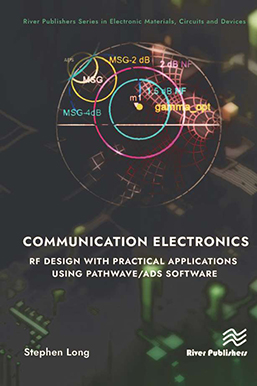
ECE Department
University of California,
Santa Barbara
My lecture notes from ECE145AB/ECE218AB have been combined and expanded into a new textbook – Communication Electronics
It has 17 chapters and includes numerous homework exercises and tutorials on using ADS for simulation of RF circuits.

- Nonideal Components and Introduction to ADS
- Transmission lines: time domain
- Transmission lines: frequency domain
- S-Parameters
- Matching Network Design
- Small-Signal Amplifier Design
- Bias Circuit Design and Wideband Amplifiers
- Performance Limitations of Amplifiers – Distortion and Noise
- Design of Low Noise Amplifiers
- Introduction to Receivers
- Mixers
- Quadrature Signals and Image Reject Mixers
- Resonators
- Oscillators
- Low Phase Noise Oscillators
- Power Amplifiers – part 1
- Power Amplifiers – part 2
The topic of radio frequency electronics is both very old and at the same time very new. When products such as cellphones and computers are designed to be obsolete in a year or two, it would appear at first glance that learning older concepts of RF engineering would be superfluous. Beginning in the early 20th century with visionaries such as Armstrong, the applications today would have been seen as science fiction back then. Yet some of what he invented, as well as much discovered from the 1920s through 1940s by many brilliant engineers are still in use today. It is my belief that in order to step up to the latest and greatest RF based circuits and systems, one must fully understand the fundamentals, many of which have been around for years.
The chapters in this book were developed from my lecture notes on a two-quarter class at the senior and graduate level at UCSB. The class had a significant lab component employing measurement techniques, board-level prototyping and RFIC design. The emphasis of the material in this book is first to develop practical intuition into the art of RF circuit design and secondly to begin the learning curve for a widely-used simulation tool, Pathwave ADS, from Keysight Technologies. The intent is to build a strong foundation based upon experience with project-oriented assignments. There are a number of books that go into the detailed mathematical derivations of these topics. My intention was to not get bogged down in these but cut to the practical applications illustrated by examples, simulation tutorials, and homework problems. Learning through doing has proven to be an effective preparation for more advanced and complex applications. Thus, the book falls somewhere between a traditional textbook with all of its derivations and a practical handbook. The book will focus mainly on analog RF analysis and design. Little is said about DSP or digital communications, topics well beyond the scope of this work.
Also, due to space constraints and that many of the components used in the lab design assignments are no longer available, I have not included a lab manual. A few lab exercises are included in the text or as homework that make use of commercially available hardware or provide a sequence of steps that are applicable to any RF transistor. The goal is to begin to develop measurement expertise and to illustrate concepts described in the text through hardware applications. Homework solutions are available.
The UCSB course also included a significant review (many pages) of feedback theory for transistor circuits, using Bode plots to analyze phase margins, compensation and use of MATLAB. This was directed toward application to phase-locked loops. Due to space constraints, it has not been feasible to include these topics in the text.
Acknowledgements: I would like to gratefully acknowledge the contributions of Prof. Mark Rodwell who also has taught these same courses. His lecture notes were also helpful to me for teaching this class and most likely have been partially included in some of the first few chapters. Our collaborations over many years have been one of the highlights of my time at UCSB. I am also very thankful for Andy Howard at Keysight Technologies who helped me climb the learning curve on ADS during a sabbatical leave in Santa Rosa. My friend Wes Hayward W7ZOI, now retired from Triquint Semiconductor, has been influential consultant in the content of the class and especially the labs. Laszlo Dobos (Maxim) helped identify the tapped inductor technique for improving phase noise. Joe Lai and Vikas Manan greatly benefitted from his mentoring, and their dissertations on low phase noise oscillators extended that work. David Leeson (Stanford) provided a section on microwave links, antenna noise modeling, and satellite receivers. I also am much grateful for the contributions of other of my former graduate students who contributed much to the description of power amplifiers included in this book. To name a few: David Choi, Tony Long, Vamsi Paidi, David Schmelzer, Shouxuan Xie, and Jingshi Yao.
Additionally, my network of Amateur Radio friends and my lifetime interest in the hobby helped guide me into developing this class on RF design after transitioning from my former focus on high-speed GaAs digital circuits.
Finally, I am so thankful for my wife, Molly, my children, Chris and Betsy, and my late parents, Stan and Mae, for their love, encouragement and support for so many years.
Colossians 3:17.
https://www.riverpublishers.com/book_details.php?book_id=1087
Professor Emeritus, Electrical and Computer Engineering,
University of California Santa Barbara
March 2023